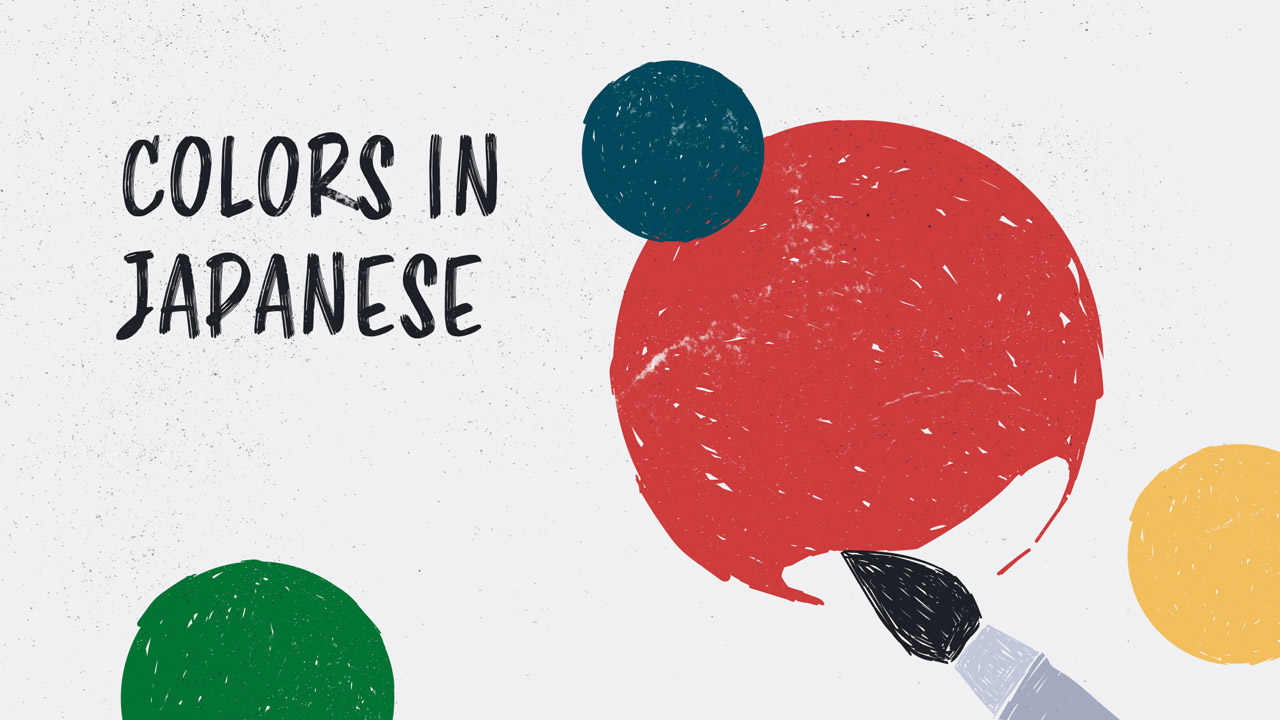Learn a Kaleidoscope of Colors in Japanese [With Examples]
If you travel to Japan, you’ll fall in love with the beautiful, color-rich scenery. The red torii of Shinto shrines, vibrant neon Harajuku fashion, or the pastel blues of Edo-era art. Colors in Japanese are a must learn for anyone interested in the language, culture, or for travel!
Besides being one of the basic building blocks of language learning, colors in Japanese hold traditional meanings. They’re often tied to the culture, and represent nobility, strength, or peace.
So learning the colors will deepen your knowledge of the culture. And it’ll give you more enjoyment during your travels to Japan.
And thankfully — they’re not too difficult to learn!
Table of contents
The Colors in Japanese: Primary Colors
Let’s jump right in with our main, basic colors. They are:
- Red: 赤, aka
- Orange: オレンジ, orenji
- Yellow: 黄色, kiiro
- Green: 緑, midori
- Blue: 青, ao
- Purple: 紫, murasaki
- White: 白, shiro
- Black: 黒, kuro
- Grey: 灰色, haiiro
- Brown: 茶色, chairo
- Pink: ピンク, pinku
These are the most common ways to hear and use the colors. But there are some alternate ways to say them.
For example, purple in Japanese is 紫 (murasaki), but sometimes you’ll hear the English loan word パープル (pa-puru) written in Katakana.
The color orange in Japanese is most often said オレンジ, the English loan word. But it does have its own native Japanese word: 橙色 (daidaiiro).
And this one you may have heard before: ホワイト (howaito). It’s also the white color in Japanese. And the English loan word is often used for things like White Day, the holiday most like our Valentine’s Day where men treat women. (Valentine’s Day in Japan is reversed: women give their loves and friends chocolates.)
Here’s a color chart plus their alternate names, in both hiragana and kanji:
| English Color | Colors in Japanese Kanji | Colors in Japanese Hiragana | Romaji | Loan Word Alternative | Romaji |
|---|---|---|---|---|---|
| Red | 赤 | あか | aka | レッド | reddo |
| Orange | 橙色 | だいだいいろ | daidaiiro | オレンジ | orenji |
| Yellow | 黄色 | きいろ | kiiro | イエロー | iero- |
| Green | 緑 | みどり | midori | グリーン | guri-n |
| Blue | 青 | あお | ao | ブルー | buru- |
| Purple | 紫 | むらさき | murasaki | パープル | pa-puru |
| White | 白 | しろ | shiro | ホワイト | howaito |
| Black | 黒 | くろ | kuro | ブラック | burakku |
| Grey | 灰色 | はいいろ | haiiro | グレー | gure- |
| Brown | 茶色 | ちゃいろ | chairo | ブラウン | buraun |
| Pink | 桃色 | ももいろ | momoiro | ピンク | pinku |
One thing to note is that several of the colors end in 色 (iro), which is the Japanese word for “color.” That will help you recognize them. Of course, colors like green in Japanese (緑, midori), don’t follow that rule, so you’ll need to memorize those.
P.S. Still need to learn how to read and write in Japanese? Check out these articles to get started:
- How to write in Japanese
- How to learn hiragana
- How to learn kanji
- All about the Japanese alphabet
- Learn your first 100 kanji
More Colors in Japanese
Cool, we’ve mastered the basics! That’s a huge first step.
But I’m sure you want to know more than the basic colors of the rainbow, right?
After all, our world is filled with all the colors in a Crayola box and more! So we need to learn how to talk about things like gold, silver, light blue, dark green, lavender, rose, turquoise, and so many more.
This is where things get a little tricky though. Because colors in Japanese don’t always align with what we expect.
For example, 桃色 actually means “peach color” in Japanese. But in Japanese, it refers to the pink color of the peach tree blossoms, not the peach fruit. The pale pink-orange of peach fruit is 肌色 (hadairo), “skin color”.
Also, 青 (ao, “blue”) is often used to describe green things. I’ll explain why in a moment, but it can get confusing sometimes.
Don’t worry though — I’ve shared some links after the list that have more colors and their hex color shades, so you can check any of them out yourself. In fact, it’d be easiest to memorize the names by looking at the color rather than trying to compare to English. So use this list to get you started.
By the way, some of these colors may seem difficult, but once you learn more Japanese, they make sense. Like 真っ黒 (makkuro) means “pitch black”. The first kanji 真 means “true” and the second one, 黒 , means “black”. Others are just the name of flowers or things in nature + 色 (iro, “color”).
So let’s take a look:
Shades of Black, White, Grey, and Browns
- Pitch black: 真っ黒 (makkuro)
- Ink black: 墨色 (sumiiro)
- Pure white: 真っ白 (masshiro)
- Off-white: 胡粉色 (gofuniro)
- Beige: ベージュ (be-ju)
- Pearl: 真珠色 (shinjuiro)
- Ivory: 象牙色 (zougeiro)
- Silver: 銀色 (giniro)
- Mouse grey: 鼠色 (nezumiiro)
- Lead: 鉛色 (namariiro)
- Slate: 藍鼠 (ainezumi)
- Sand: 砂色 (sunairo)
- Chestnut: 栗色 (kuriiro)
- Earth brown: 土色 (tsuchiiro)
- Rust or Chocolate brown: 錆色 (sabiiro)
Shades of Red, Orange and Yellow
- Pure red (also “bright red” or “deep red”): 真っ赤 (makka)
- Scarlet: 緋色 (hiiro)
- Strawberry: 紅色 (beniiro)
- Bright red: 紅緋 (benihi)
- Vermilion: 朱色 (shuiro)
- Auburn: 鳶色 (tobiiro)
- Maroon: 小豆色 (azukiiro)
- Amber: 琥珀色 (kohakuiro)
- Persimmon: 柿色 (kakiiro)
- Apricot: 杏色 (anzuiro)
- Mandarin orange: みかん色 (mikaniro)
- Bronze: 青銅色 (seidouiro)
- Gold: 金色 (kiniro)
- Sunflower: ひまわり色 (himawariiro)
- Mustard: からし色 (karashiiro)
Shades of Green and Blue
- Jade green: 翡翠色 (hisuiiro)
- Olive green: 鶯色 (uguisuiro)
- Moss green: 苔色 (kokeiro)
- Evergreen: 千歳緑 (chitosemidori)
- Forest green: 常盤色 (tokiwairo)
- Pea green: 柳色 (yanagiiro)
- Spring green (yellow-green): 萌黄色 (mogiiro)
- Teal: 鴨の羽色 (kamonohairo)
- Green-blue: 青緑色 (aomidoriiro)
- Pure blue (also “deep blue”): 真っ青 (massao)
- Lapis blue (also sapphire blue or royal blue): 瑠璃色 (ruriiro)
- Aqua: 納戸色 (nandoiro)
- Celadon: 青磁色 (seijiro)
- Cyan: 浅葱色 (asagiiro)
- Sky blue (also “water blue”): 水色 (mizuiro)
- Powder blue: 空色 (sorairo, literally “sky blue” but closer to powder blue)
- Navy blue: 紺色 (koniro)
- Indigo: 藍 (ai)
Shades of Pink and Purple
- Peach: 肌色 (hadairo, literally “skin color”)
- Light pink: 桜色 (sakurairo, literally “cherry blossom pink”)
- Rose: 薔薇色 or バラ色 (both read barairo)
- Blush pink: 紅梅色 (koubaiiro)
- Azalea or Cherry pink: 躑躅色 (tsutsujiiro)
- Peony: 牡丹色 (botaniro)
- Coral: 珊瑚色 (sangoiro)
- Lavender: 藤色 (fujiiro)
- Violet: 菫色 (sumireiro)
- Iris: 菖蒲色 (shoubuiro)
- Blue-purple: 青紫色 (aomurasaki)
- Grape, or purple-red: 葡萄色 (ebiiro)
- Plum: 梅紫 (umemurasaki)
- Eggplant: 茄子紺 (nasukon)
Don’t see a color you want to know here? No worries. Check out this list of traditional Japanese colors (with English names, plus hex colors and RGB for you color geeks out there).
There’s also this incredible site dedicated to learning Japanese colors and where the name comes from. I found this site insanely helpful for remembering the colors. It tells you the kanji meaning, English name, hex code, but also some facts about the color and related colors.
Japanese Color Names as Nouns and Adjectives: Grammar Usage
All the colors above are nouns, but blue, red, black, and white can become adjectives by adding い (i) to the end.
- Blue: 青, ao → 青い, aoi
- Red: 赤, aka → 赤い, akai
- Black: 黒, kuro → 黒い, kuroi
- White: 白, shiro → 白い, shiroi
Yellow can also add an い to become an adjective: 黄色い (kiiroi). But the い has to attach to the kanji 色 (iro), not the kanji indicating color. Same with 茶色い (chairoi) for “brown”.
So how do you use the colors in a sentence?
If it’s an い-adjective, you can simply attach it to the front of the noun.
赤いカバン akai kaban “Red bag”
But if you’re using the colors as a descriptive noun, you need to use the Japanese particle の (no) to attach the two nouns together.
赤のカバン aka no kaban “Red bag” (This has the same meaning as 赤いカバン.)
ピンクの花 pinku no hana “Pink flower”
Or, you could say “(Noun) is (color)” like:
この花はピンクです。 kono hana wa pinku desu “That flower is pink.”
Pretty simple!
Words Related to Colors
There are some other words related to colors you might want to learn about too.
For example, how do you say something is “colorful” in Japanese? There are a few ways.
Both 色鮮やかな (iro azayakana) and 色彩豊かな (shikisai yutakana) can be used as adjectives to say “colorful”.
But there’s also カラフル (karafuru), an English loan word for “colorful” in Japanese.
Be careful though! You might think “colorful” would be 色っぽい (iroppoi) — but that actually means “sexy” in Japanese.
Same with 色々な (iroirona). This means “several” or “various” but doesn’t mean “colorful” like you might think.
“Rainbow” in Japanese is 虹 (niji). Put it with 色 and you get “rainbow-colored”, 虹色 (nijiiro). Similarly, you can use 多色の (tashokuno) to say “multi-colored”.
If something has no color, you can use 無色 (mushoku) for “colorless”.
Like “colorful”, ネオン (neon) is a loan word for “neon” in Japanese.
A couple other similar words:
- Iridescent: 玉虫色 (tamamushiiro)
- Holographic: ホログラフィック (horogurafikku)
- Opal: オパール (opa-ru) or 乳白色 (nyuuhakushoku, also “milky white”)
- Transparent or clear: 透明 (toumei)
- Bright (color or light): 明るい (akarui)
- Light or pale (color): 淡い (awai)
- Vivid (color): 鮮やかな (azayaka na)
- Light (color or also “thin”): 薄い (usui)
- Dark (color): 濃い (koi)
You can use the adjectives to describe colors, like 濃い赤 (koiaka) for “dark red” or 鮮やかな紫 (azayaka na murasaki) for “vivid purple”.
Meaning of Colors in Japanese Culture
The four main traditional colors of Japan are red, white, black, and blue. In fact, a long time ago, all colors fell into those four categories.
Remember how I said blue is often used to describe green? This is why. Green, in fact, was considered a shade of blue and not a color of its own for a long time.
That’s why if you’ve studied Japanese for a while, you’ve probably heard how they say stoplights “turn blue” — 青になる (ao ni naru) — rather than turn green.
This happens in many instances where Japanese people still use 青 (ao), “blue”, instead of 緑 (midori), green. Originally, 緑 meant greenery, like trees, not a color. Even so, you’ll hear 青葉 (aoba) for “green leaves”.
So this can be tricky at times.
The color red in Japanese culture is obviously very important. Red is a color of protection against evil. That’s why the Shinto torii are red, to protect and repel evil.
But also, red is the color of the kami, the gods or spirits of Shintoism. So red holds religious, spiritual, and powerful meanings. But it’s also associated with peace, prosperity, and strength.
It’s the complete opposite of how Western society views red, where it’s seen as the color of both passion and aggression, and often associated with evil (like the red devil). Normally, blue is the color of peace in Western culture.
But blue used to mark the evil character in Kabuki.
Outside of Kabuki, though, blue is mystic and royal. For a long time, blue and purple were the color of nobility and the elite. In fact, purple flowers were the emblem of several shogunates, such as the Tokugawa shogunate.
Back then, only the elite were allowed to wear blue and purple. But during the Edo period where art really took off, many people began wearing indigo blue. It’s still one of the most popular traditional colors of Japan and is considered a lucky color.
Like in Western culture, white symbolizes purity. But it’s also strongly tied with the spiritual world, and it used to be the color you wore to funerals.
Now, though, Japan has been influenced by Western culture and black has become the color for funerals.
Like purple and blue were the colors of the elite, black was the color of the poor in old Japan. But later, black became a color of beauty and was used often in traditional makeup. Women even dyed their teeth black to look more beautiful!
A Kaleidoscope of Colors in Japanese
Life is colorful — so don’t forget to enjoy it in Japanese, too!
Now that you’ve learned so many colors and ways to use them, you can go forth and add more color to your Japanese conversations.
What will you learn next in Japanese? Why not learn about “kawaii” culture in Japan, get inspired by Japanese proverbs, or all about Japanese food?







Social